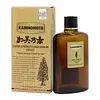What's inside
What's inside
 Key Ingredients
Key Ingredients

 Benefits
Benefits

 Concerns
Concerns

 Ingredients Side-by-side
Ingredients Side-by-side

O-Cymen-5-Ol
AntimicrobialPanthenol
Skin ConditioningTocopheryl Acetate
AntioxidantAllantoin
Skin ConditioningGlycyrrhetinic Acid
Skin ConditioningIsodon Trichocarpus Extract
MaskingSophora Angustifolia Root Extract
Skin ConditioningGum Base
Glycerin
HumectantMenthol
MaskingHinokitiol
Rosmarinus Officinalis Leaf Extract
AntimicrobialPEG-40 Hydrogenated Castor Oil
EmulsifyingParfum
MaskingAlcohol
AntimicrobialWater
Skin ConditioningWater
Skin ConditioningAlcohol Denat.
AntimicrobialMenthol
MaskingTromethamine
BufferingSalicylic Acid
MaskingPanthenol
Skin ConditioningBiotin
AntiseborrhoeicButylene Glycol
HumectantMentha Piperita Leaf Extract
Skin ConditioningMentha Viridis Extract
MaskingMentha Rotundifolia Leaf Extract
TonicGlycine Max Seed Extract
Skin ConditioningNigella Sativa Seed Extract
PerfumingOryza Sativa Extract
AbsorbentRibes Nigrum Fruit Extract
AstringentSesamum Indicum Sprout Extract
HumectantSalvia Hispanica Seed Extract
EmollientVaccinium Angustifolium Fruit Extract
Skin ProtectingHydrolyzed Centella Asiatica Extract
AntioxidantMadecassoside
AntioxidantMadecassic Acid
Skin ConditioningAsiaticoside
AntioxidantAsiatic Acid
Skin ConditioningCamellia Sinensis Leaf Extract
AntimicrobialHouttuynia Cordata Extract
Skin ConditioningLeonurus Sibiricus Flower/Leaf/Stem Extract
SoothingNelumbo Nucifera Flower Extract
Skin ConditioningArtemisia Vulgaris Extract
Skin Conditioning1,2-Hexanediol
Skin ConditioningEthylhexylglycerin
Skin ConditioningCaprylyl Glycol
EmollientParfum
MaskingWater, Alcohol Denat., Menthol, Tromethamine, Salicylic Acid, Panthenol, Biotin, Butylene Glycol, Mentha Piperita Leaf Extract, Mentha Viridis Extract, Mentha Rotundifolia Leaf Extract, Glycine Max Seed Extract, Nigella Sativa Seed Extract, Oryza Sativa Extract, Ribes Nigrum Fruit Extract, Sesamum Indicum Sprout Extract, Salvia Hispanica Seed Extract, Vaccinium Angustifolium Fruit Extract, Hydrolyzed Centella Asiatica Extract, Madecassoside, Madecassic Acid, Asiaticoside, Asiatic Acid, Camellia Sinensis Leaf Extract, Houttuynia Cordata Extract, Leonurus Sibiricus Flower/Leaf/Stem Extract, Nelumbo Nucifera Flower Extract, Artemisia Vulgaris Extract, 1,2-Hexanediol, Ethylhexylglycerin, Caprylyl Glycol, Parfum
 Reviews
Reviews

Ingredients Explained
These ingredients are found in both products.
Ingredients higher up in an ingredient list are typically present in a larger amount.
Menthol is a compound found in mint plants, such as peppermint. In its pure form, it is a clear crystalline substance.
Menthol is known for its cooling sensation; however, the cooling is actually from your skin being sensitized. Menthol can worsen rosacea. We recommend speaking with a professional if you have concerns.
Menthol also has antimicrobial properties.
Learn more about MentholPanthenol is a common ingredient that helps hydrate and soothe the skin. It is found naturally in our skin and hair.
There are two forms of panthenol: D and L.
D-panthenol is also known as dexpanthenol. Most cosmetics use dexpanthenol or a mixture of D and L-panthenol.
Panthenol is famous due to its ability to go deeper into the skin's layers. Using this ingredient has numerous pros (and no cons):
Like hyaluronic acid, panthenol is a humectant. Humectants are able to bind and hold large amounts of water to keep skin hydrated.
This ingredient works well for wound healing. It works by increasing tissue in the wound and helps close open wounds.
Once oxidized, panthenol converts to pantothenic acid. Panthothenic acid is found in all living cells.
This ingredient is also referred to as pro-vitamin B5.
Learn more about PanthenolParfum is a catch-all term for an ingredient or more that is used to give a scent to products.
Also called "fragrance", this ingredient can be a blend of hundreds of chemicals or plant oils. This means every product with "fragrance" or "parfum" in the ingredients list is a different mixture.
For instance, Habanolide is a proprietary trade name for a specific aroma chemical. When used as a fragrance ingredient in cosmetics, most aroma chemicals fall under the broad labeling category of “FRAGRANCE” or “PARFUM” according to EU and US regulations.
The term 'parfum' or 'fragrance' is not regulated in many countries. In many cases, it is up to the brand to define this term.
For instance, many brands choose to label themselves as "fragrance-free" because they are not using synthetic fragrances. However, their products may still contain ingredients such as essential oils that are considered a fragrance by INCI standards.
One example is Calendula flower extract. Calendula is an essential oil that still imparts a scent or 'fragrance'.
Depending on the blend, the ingredients in the mixture can cause allergies and sensitivities on the skin. Some ingredients that are known EU allergens include linalool and citronellol.
Parfum can also be used to mask or cover an unpleasant scent.
The bottom line is: not all fragrances/parfum/ingredients are created equally. If you are worried about fragrances, we recommend taking a closer look at an ingredient. And of course, we always recommend speaking with a professional.
Learn more about ParfumWater. It's the most common cosmetic ingredient of all. You'll usually see it at the top of ingredient lists, meaning that it makes up the largest part of the product.
So why is it so popular? Water most often acts as a solvent - this means that it helps dissolve other ingredients into the formulation.
You'll also recognize water as that liquid we all need to stay alive. If you see this, drink a glass of water. Stay hydrated!
Learn more about Water